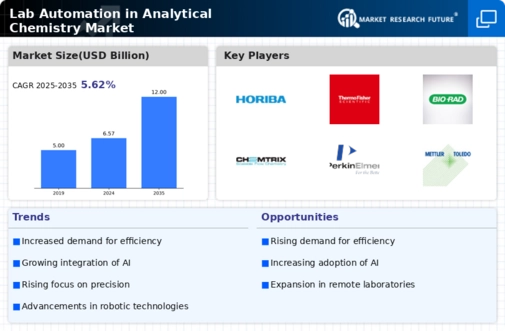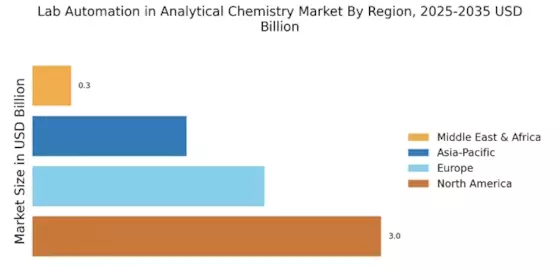Emergence of Personalized Medicine
The Lab Automation in Analytical Chemistry Market is witnessing a shift towards personalized medicine, which is driving the demand for tailored analytical solutions. As healthcare moves towards individualized treatment plans, laboratories require automation systems that can accommodate diverse sample types and complex analyses. This trend necessitates the development of flexible and adaptable automated systems capable of handling various assays and workflows. The market for personalized medicine is expected to expand significantly, with projections indicating a growth rate of approximately 11% in the coming years. This shift underscores the need for automation in analytical chemistry to support the evolving landscape of healthcare and precision medicine.
Regulatory Compliance and Quality Assurance
The Lab Automation in Analytical Chemistry Market is significantly influenced by the stringent regulatory requirements imposed on laboratories. Compliance with regulations such as Good Laboratory Practice (GLP) and Good Manufacturing Practice (GMP) necessitates the implementation of automated systems that ensure consistent quality and reliability of analytical results. Automation aids in maintaining meticulous records, reducing the likelihood of human error, and facilitating traceability, which are essential for regulatory compliance. As laboratories strive to meet these standards, the demand for automated solutions is expected to rise. Market analysis suggests that the regulatory compliance segment will witness a growth trajectory of approximately 8% over the next few years, highlighting the critical importance of automation in achieving quality assurance.
Rising Demand for High Throughput Screening
The Lab Automation in Analytical Chemistry Market is experiencing a notable increase in demand for high throughput screening (HTS) technologies. This trend is driven by the need for rapid and efficient analysis in drug discovery and development processes. HTS allows laboratories to conduct thousands of tests simultaneously, significantly reducing the time required for research and development. As pharmaceutical companies seek to accelerate their pipelines, the adoption of automated systems that facilitate HTS is likely to rise. Market data indicates that the HTS segment is projected to grow at a compound annual growth rate (CAGR) of approximately 10% over the next five years, reflecting the increasing reliance on automation in analytical chemistry.
Increased Focus on Data Management and Analysis
In the Lab Automation in Analytical Chemistry Market, there is a growing emphasis on data management and analysis capabilities. As laboratories generate vast amounts of data from automated processes, the need for sophisticated data management systems becomes paramount. These systems enable researchers to efficiently analyze and interpret data, leading to more informed decision-making. The integration of advanced data analytics tools with laboratory automation systems is likely to enhance productivity and streamline workflows. Market trends indicate that the data management segment is projected to grow at a CAGR of around 9%, reflecting the increasing importance of data-driven approaches in analytical chemistry.
Advancements in Robotics and Automation Technologies
Technological advancements in robotics and automation are transforming the Lab Automation in Analytical Chemistry Market. Innovations in robotic systems, such as improved precision and flexibility, enable laboratories to automate complex tasks that were previously performed manually. These advancements not only enhance the efficiency of laboratory operations but also improve the accuracy of analytical results. The integration of sophisticated robotic systems is expected to drive market growth, as laboratories increasingly seek to minimize human error and optimize workflows. Furthermore, the market for robotic automation in laboratories is anticipated to expand, with projections suggesting a growth rate of around 12% annually, underscoring the pivotal role of technology in shaping the future of analytical chemistry.

















Leave a Comment